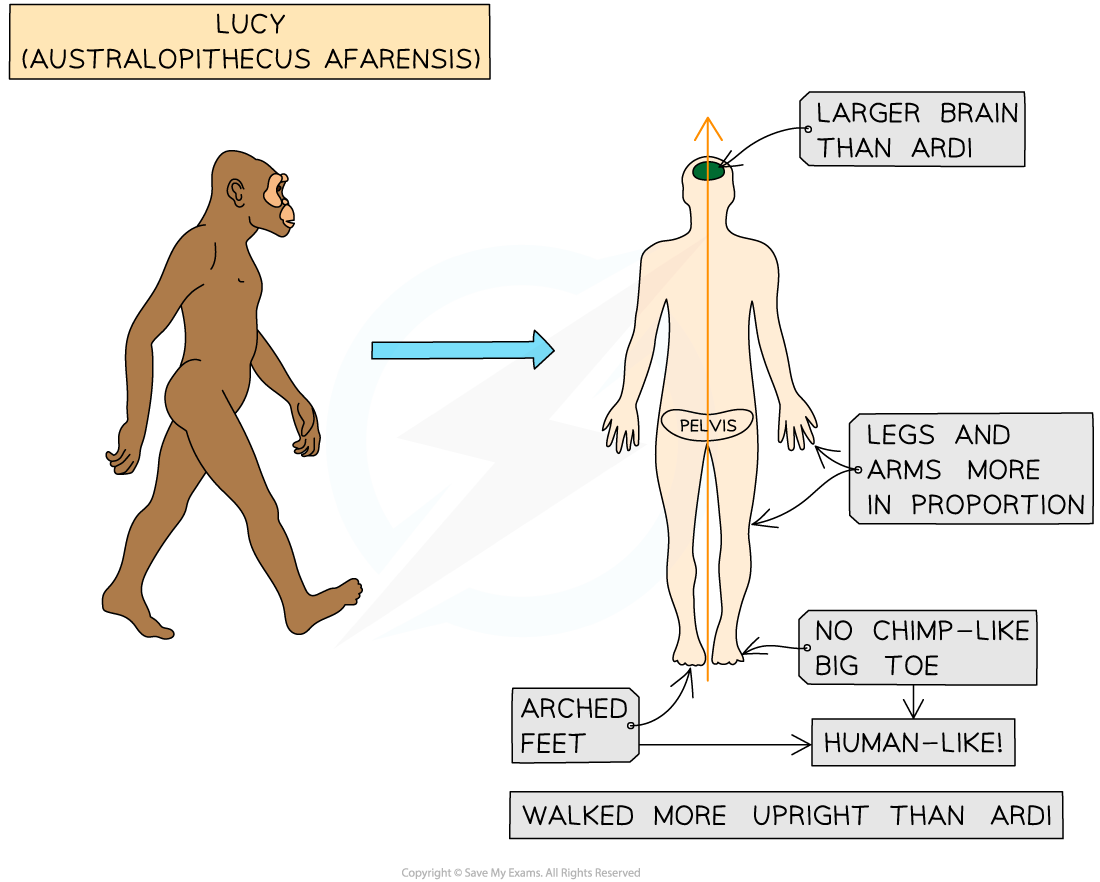Evidence of Evolution (Edexcel GCSE Biology): Revision Note
Exam code: 1BI0
Evidence of Evolution
There is a large amount of fossil evidence suggesting that modern-day humans (Homo sapiens) evolved from a common ancestor with other apes
For example, fossil evidence shows that humans (Homo sapiens) and chimpanzees (Pan troglodytes) evolved from a common ancestor that existed approximately 6 million years ago
Humans and their ancestors are known as hominids
Fossils from several different hominid species have been discovered, all with various characteristics that lie somewhere between apes and humans
By studying these fossils, evolutionary biologists have been able to understand more about how humans have evolved over time
'Ardi' the fossil hominid
'Ardi' is the name given to a fossil (more specifically, 125 fragments of fossilised bone) of a female individual of the species Ardipithecus ramidus
Ardi was found in Ethiopia and is 4.4 million years old
Ardi's features are a mixture of those seen in apes and humans. For example:
Ardi's foot structure suggests that she climbed trees (the fossils show she had an ape-like big toe to help grip onto branches)
Ardi had short legs but long arms (more similar to an ape than to a human)
Ardi's brain was around the same size as a chimpanzee's
But Ardi's leg bone structure suggests she walked upright. This theory is supported by her hand bone structure, which suggests she did not use her hands when walking (like apes do)

Ardi - a fossil hominid of the species Ardipithecus ramidus
'Lucy' the fossil hominid
'Lucy' is the name given to a fossil (again, made up of over a hundred fragments of fossilised bone) of a female individual of the species Australopithecus afarensis
Lucy was also found in Ethiopia but is less old than Ardi (Lucy is 3.2 million years old)
Like Ardi, Lucy's features are also a mixture of those seen in apes and humans. However, she is more human-like than Ardi. For example:
Lucy's foot structure shows she had arched feet (better adapted to walking compared to climbing) and did not have an ape-like big toe
The size of her legs and arms were still somewhere between those of an ape and those of a human but were less ape-like than Ardi's
Lucy's brain was slightly larger than Ardi's (although still similar in size to a chimpanzee's brain)
Like Ardi, Lucy's leg bone structure suggests she walked upright (but more efficiently than Ardi)

Lucy - a fossil hominid of the species Australopithecus afarensis
Leakey and his hominid fossil discoveries
In 1984, a scientist called Richard Leakey led an expedition to Kenya to search for hominid fossils
The team on the expedition found many fossils of individuals from the genus Australopithecus and the genus Homo
'Turkana Boy' is the name given to one of these fossil skeletons (of a male individual of the species Homo erectus)
Turkana Boy is 1.6 million years old (less old than Lucy)
Like Ardi and Lucy, Turkana Boy's features are a mixture of those seen in apes and humans. However, he is even more human-like than Lucy. For example:
The size of his legs and arms were much closer to those of a human than of an ape
His brain was much larger than Lucy's (similar in size to a human brain)
The structure of his legs and feet suggests he walked upright even more efficiently than Lucy

Turkana Boy - a fossil hominid of the species Homo erectus
The development of stone tools
In addition to all these hominid fossils, findings of the stone tools used by various hominid species over time provide strong evidence for human evolution
As different species within the genus Homo evolved, they started using stone tools that gradually became more complex over evolutionary time (as their brains were also evolving to be larger and larger)
These stone tools, as well as the hominid fossils, can be dated (i.e. have their age determined) in a few ways:
By looking at the structural features of the tool or fossil (e.g. simpler tools are probably older than more complex tools)
By using stratigraphy (the study of rock layers). Older rock layers are usually found below younger rock layers, meaning that tools or fossils found in deeper layers are probably older)
By using Carbon-14 dating (fossils contain carbon and stone tools are sometimes found along with carbon-containing materials e.g. a wooden tool handle)
Tool Use by Homo Species over Evolutionary Time Table


Unlock more, it's free!
Did this page help you?